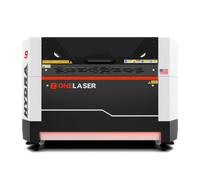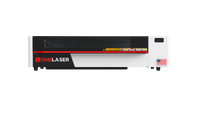Laser engravers are powerful creative tools, capable of turning digital designs into physical masterpieces on materials like wood, acrylic, glass, leather, and more. But with great power comes great responsibility. Understanding and applying proper laser engraving safety practices is critical whether you’re a hobbyist or professional.
In this comprehensive guide, we’ll walk you through key laser engraver safety rules, common hazards, must-know tips, and how laser engraving machines integrate smart safety systems to help you create confidently and safely.
1. What are Laser Hazards?
Laser engravers use concentrated light beams (typically CO₂ lasers) to cut or engrave materials with precision. But this high-energy process can expose users to serious risks:
- Eye injuries from direct or reflected laser beams
- Skin burns from the intense heat
- Toxic fumes from vaporized materials
- Fire hazards from flammable substances
To address these risks, laser engraving machines like the OneLaser X Series and Hydra Series are designed with built-in laser engraver safety features. Their automatic lid detection systems prevent the laser from operating unless the cover is securely closed, minimizing exposure to harmful radiation.
While both models operate under Class 2 safety standards, they house powerful Class 4 CO₂ lasers, so following laser engraver safety rules and laser cutting safety precautions is critical. Never disable safety interlocks, always wear protective eyewear, and keep your workspace clean and supervised.

2. Built-in Laser Safety - Lid Interlock System
A key laser engraver safety feature in the OneLaser X Series and Hydra Series is the lid lock system.
It’s simple: the laser won’t start unless the lid is fully closed. If you open the lid while it’s running, the machine stops right away. This protects you from laser exposure and high heat.
OneLaser calls this safety rule:
“No Covered Lids, No Operation, No Risks.”
Why is this important? Because even a quick glance at the laser beam can hurt your eyes or skin. The lid lock keeps you safe, whether you’re a beginner or a pro.
It’s a small feature, but it makes a big difference. You don’t have to worry about forgetting anything—the machine takes care of it for you.
With OneLaser, laser engraving safety is built in, so you can focus on your project with confidence.

3. Laser Engraving Safety Tips for Your Workspace
A well-prepared workspace is your first line of defense. When using a laser cutting machine, safety precautions must include air quality, cleanliness, and access control.
✅ Good Ventilation Matters
Laser engraving emits fumes and fine particles, especially when engraving plastic, wood, or leather. Prolonged exposure can harm your lungs.
That’s why OneLaser equips its machines with the FumeGuard™ filtration system, effectively controlling and extracting toxic fumes. Whether you’re engraving in a studio or garage, always ensure:
- Proper exhaust system is installed
- The area is well-ventilated
- Filters are replaced as needed

✅ No Flammable Objects Nearby
Always clear your laser bed and surroundings before operation. Leftover scraps or cloth can catch fire quickly.
- Never leave the laser unattended.
- Keep a CO₂ fire extinguisher nearby.
- Remove excess debris or finished pieces before running a new job.
4. Material Safety: Know What You’re Engraving
One key rule of laser engraving safety is to always check if your material is safe to use. Some materials can release toxic fumes or even catch fire when engraved.
Avoid materials like:
- PVC (polyvinyl chloride)
- Vinyl
- Some foams and unknown plastics
These can produce harmful gases and damage your laser machine.
Safe materials include:
- Wood
- Acrylic
- Leather
- Paper
- Anodized aluminum
Learn more: Laser Engraving Settings for Different Materials
The OneLaser X Series makes this easier with preset settings for popular materials. It also includes RedDot technology for precise laser alignment—helping you avoid mistakes and keep your project safe.

When in doubt, double-check the material before engraving. A quick check can protect your health, your machine, and your workspace.
5. Fire Risk and Temperature Monitoring
Laser engravers use high heat to cut and engrave, which means there’s always a small risk of fire, especially when working with materials like wood, paper, fabric, or leather.
That’s why laser cutting safety precautions are so important.
To help prevent fires, OneLaser Machines include smart safety features that monitor temperature during use. If the machine gets too hot, it will automatically shut down to protect both you and the machine.

Here are a few simple safety tips to reduce fire risk:
- Always stay near the machine while it’s running—never leave it unattended.
- Remove scraps or leftover pieces from the laser bed before starting a new job.
- Keep a CO₂ fire extinguisher close by, just in case.
- Use Air Assist (included in OneLaser machines) to blow away heat and debris while cutting.
Even though the machine has built-in safety systems, your attention still plays a big role in laser engraver safety. Being alert, prepared, and following these tips will help keep your workspace safe and your projects worry-free.
6. Safety Equipment: What You Need
Using proper personal protective equipment (PPE) is essential, especially during maintenance or when operating open-lid systems.
Essential PPE:
- Safety goggles (rated for CO₂ lasers)
- Respirator or mask (especially for prolonged use or poor ventilation)
- Gloves when handling harsh materials or cleaning residue
Even if the laser is enclosed, it's good practice to wear protective eyewear when performing alignment or maintenance tasks.
7. Training and Operational Awareness
Even though laser engravers are designed to be user-friendly, they still require proper training. These are powerful machines—not plug-and-play tools—and using them without understanding the basics can lead to mistakes or safety risks.
Before using your machine, make sure to:
- Read the user manual carefully
- Attend training or onboarding sessions
- Understand how safety interlocks and emergency stops work
- Learn the correct material settings for power and speed
The X Series includes an intuitive touchscreen interface and guided setup, making it easier for beginners to get started safely.
Learn more: How to Set Up a Laser Engraver

Plus, OneLaser provides U.S.-based support and lifetime help from expert engineers—so you're never left on your own.
A little preparation goes a long way in helping you work smarter, safer, and with more confidence.
8. Maintenance: Clean Machine = Safe Machine
Keeping your laser engraver clean and well-maintained is one of the easiest ways to stay safe and extend the life of your machine. A poorly maintained engraver is more likely to have problems like overheating, reduced cutting power, or even safety failures.
Regular maintenance helps prevent breakdowns, keeps your projects running smoothly, and ensures all safety features work as intended.
Here are a few laser engraver maintenance tips:
- Clean the laser bed and optics regularly to remove dust, debris, and material residue.
- Check the air assist system to make sure it’s blowing properly and preventing flare-ups.
- Inspect the fume extractor and lid sensors to ensure they are clean and working correctly.
- Look for any loose wires or damaged components, especially after moving the machine.
- Replace filters on schedule to keep airflow clean and strong.
- Remove leftover scraps and flammable materials from inside the machine after each job.
Most importantly, never bypass or disable safety systems, remove protective covers, or try to make unauthorized changes to the machine. This not only increases the risk of injury or fire—but it also voids your warranty.
By keeping your machine in top shape, you ensure every engraving job is safe, clean, and high-quality. A little routine care goes a long way.
9. Company Guidelines & Professional Use
If you're using a laser engraver in a school, business or shared makerspace, it's important to have clear safety rules to keep everyone safe and the machine running properly. Here’s what you should do:
- Create internal laser engraver safety rules that are simple and easy to follow.
- Allow only trained and authorized staff to operate or repair the machine.
- Define clear roles and responsibilities for operation, maintenance, and supervision.
- Have all staff read and sign off on the safety protocols before using the machine.
- Keep the area around the laser clean and clear, with easy access to the emergency stop button.
- Never store flammable materials near the machine or leave it unattended while operating.
- Hold regular safety training sessions to keep everyone updated.
- Maintain written records of all training, safety checks, and updates for accountability and compliance.
Following these steps helps create a safe and professional environment where your team can work confidently and efficiently with your laser engraver.
10. Introducing the OneLaser Machines
If you’re looking for a laser engraver that offers both top performance and strong safety features, OneLaser is a trusted choice. Both the X Series and Hydra Series are built to deliver professional results while keeping safety front and center—perfect for beginners, small businesses, or busy production shops.
🔷 OneLaser X Series – Safe and Easy for All Skill Levels
- Lid Safety Lock: Laser won’t run unless the lid is fully closed
- FumeGuard™ Filtration System: Helps maintain clean, breathable air
- RedDot Alignment: Accurate laser positioning for safer engraving
- User-Friendly Touchscreen: Simple setup and controls
- Preloaded Material Settings: Safe, optimized power and speed for different materials
Great for crafters, startups, and anyone new to laser engraving.
Explore the OneLaser X Series!

🔷 OneLaser Hydra Series – Power and Protection for Professionals
- Dual-Laser Compatibility: Supports both RF and glass tube lasers
- Advanced Safety Interlocks: Stops the laser if the lid is opened
- Air Assist and Temperature Monitoring: Helps reduce fire risk and overheating
- Industrial-Grade Build: Designed for long jobs and high-volume use
Ideal for workshops, engraving businesses, and production environments.
Discover the OneLaser Hydra Series!

✅ Additional Benefits (Both Series)
- U.S.-based R&D and technical support
- 3-year limited warranty
- Access to the OneLaser community for help, ideas, and learning
Whether you're customizing gifts or scaling a business, OneLaser gives you the tools—and safety features—you need to engrave with confidence.
FAQs:
What are the hazards of laser engraving?
Eye damage, burns, fire hazards, and toxic fume inhalation are the primary risks.
Is it safe to look at a laser engraver?
Never directly or indirectly look at the beam. Always use safety goggles during open-lid operations.
What are the basic safety precautions for laser use?
Wear goggles, ensure ventilation, avoid dangerous materials, and follow the manufacturer’s manual.
Do I need ventilation when laser engraving?
Absolutely. Fume extraction or air filtration is necessary to prevent inhaling harmful substances.
Should I wear a mask while laser engraving?
Yes, especially if engraving for long hours or working with materials like leather or plastics.
Can laser engravers cause fires?
Yes, especially when cutting flammable materials. Always supervise your machine during operation.
What PPE do I need?
At minimum: safety goggles and a mask. Gloves are optional but recommended when handling residue or chemicals.
Have Questions? Contact Us Now!
Final Thoughts
Laser engraving opens up amazing creative and business possibilities, but laser engraving safety should always come first. Machines like the OneLaser X Series and Hydra Series are built with user protection in mind, offering smart sensors, real-time controls, and intuitive safety mechanisms.
By following the proper laser cutting safety precautions and leveraging OneLaser’s built-in safeguards, you can enjoy precise results and peace of mind—every single time.






